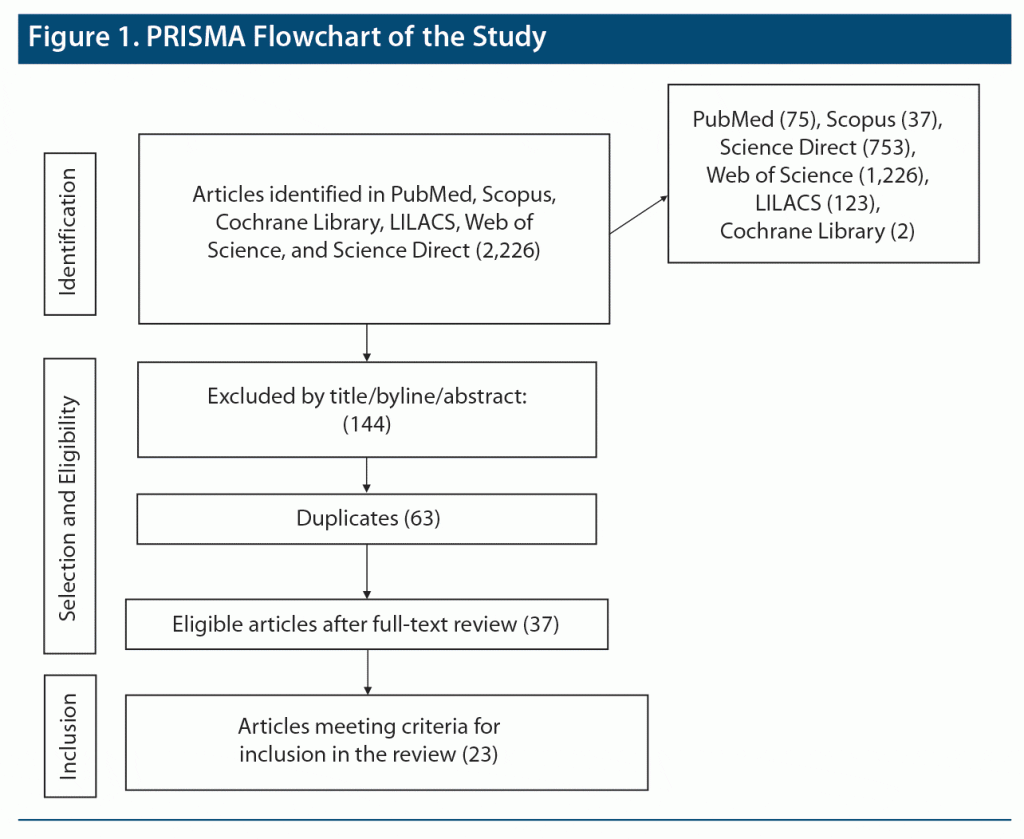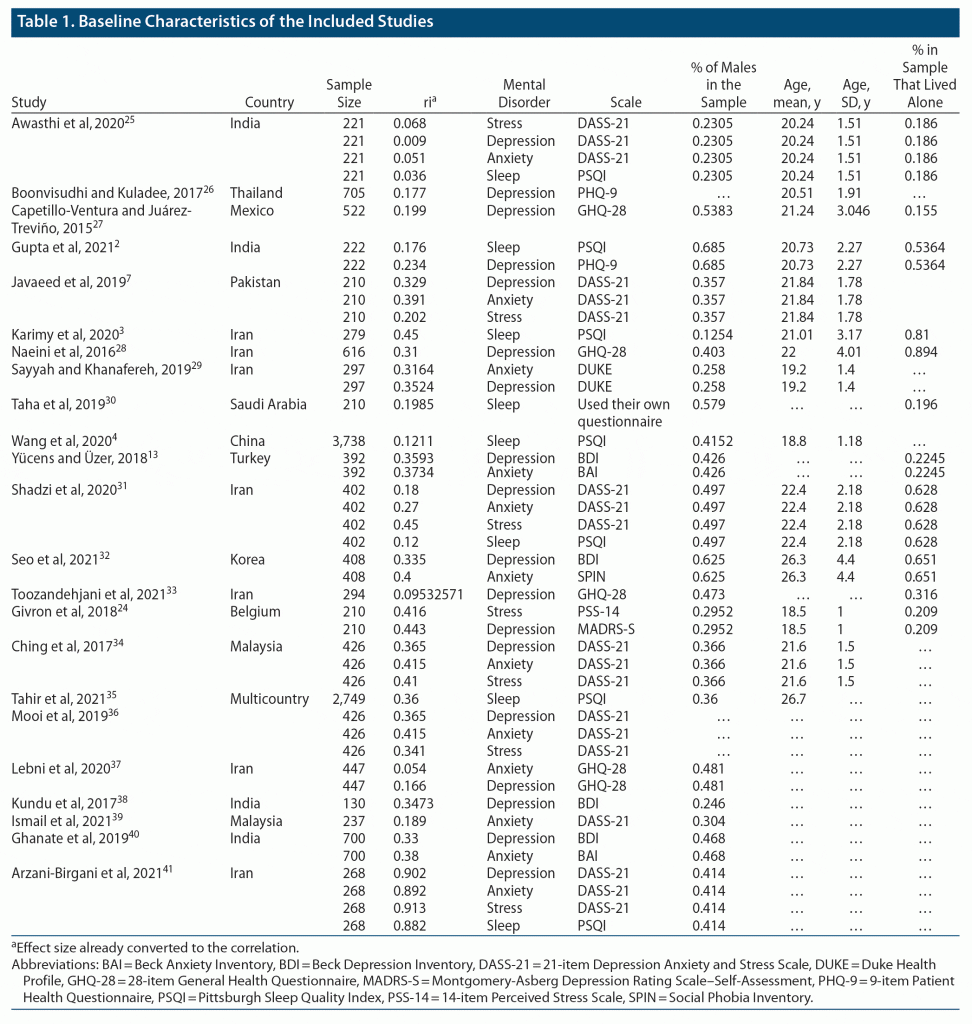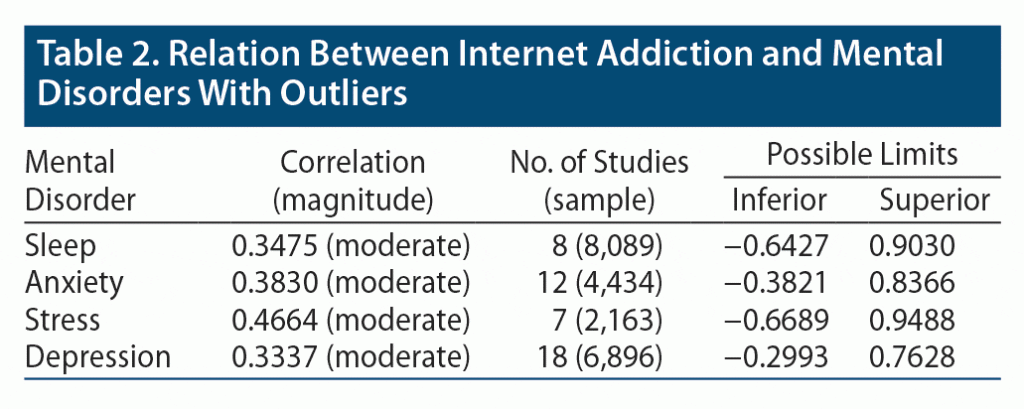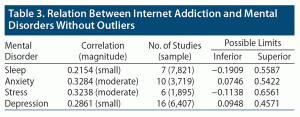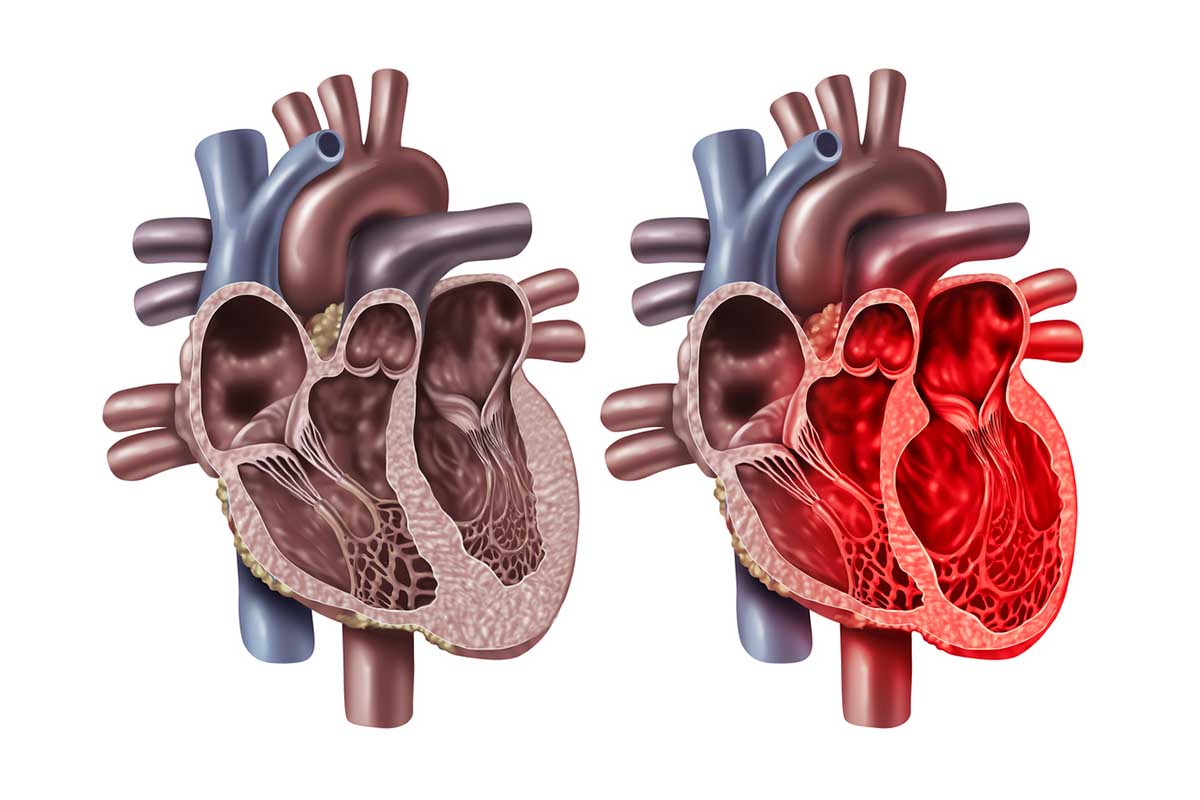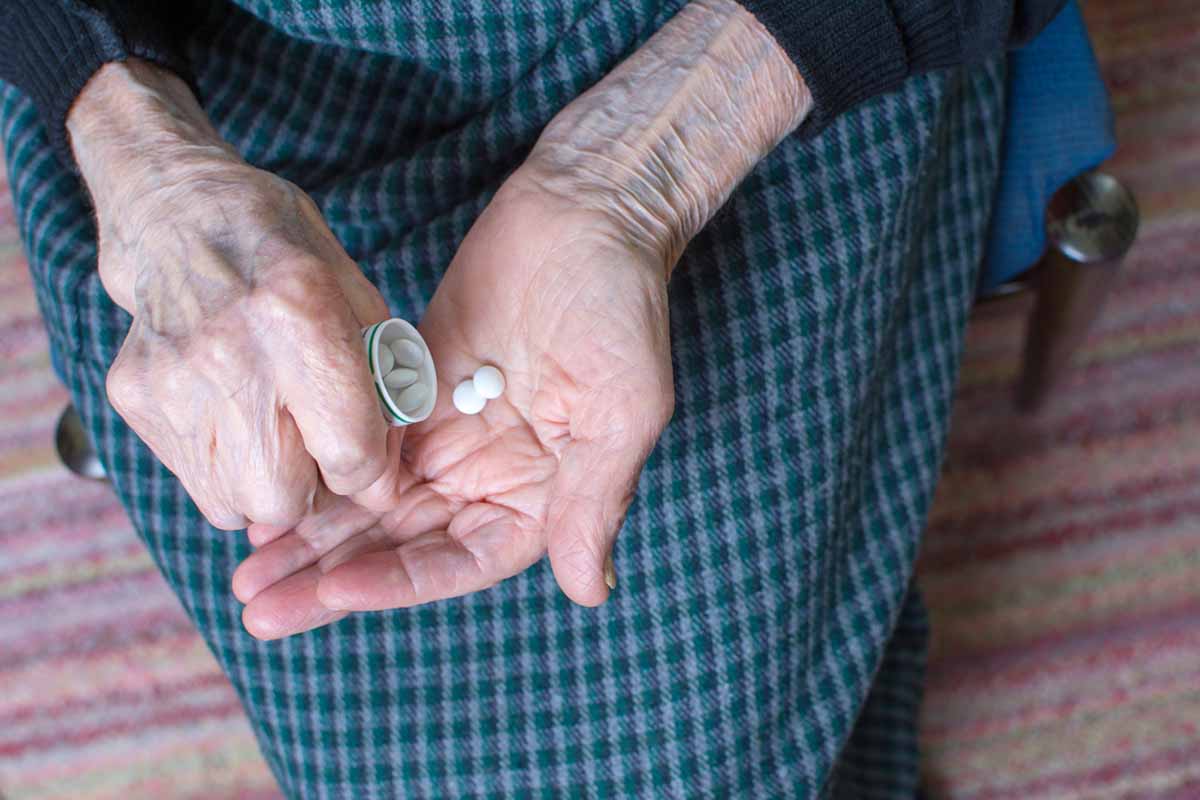ABSTRACT
Objective: Internet addiction disorder (IAD) is associated with psychological, physical, and social problems, including impaired academic performance. The objective of this review was to investigate the relationship between IAD and psychiatric disorders in medical students.
Data Sources: A search of PubMed, LILACS (Latin American and Caribbean Health Sciences Literature), Scopus, Cochrane Library, Web of Science, and Science Direct was performed using the following keywords: internet addiction disorder OR problematic internet use OR pathological internet use OR internet overuse OR heavy internet use AND medical students AND internet addiction OR problematic internet use OR pathological internet use OR internet overuse OR heavy internet use AND physicians.
Study Selection: Articles were selected and extracted from the online databases. Articles were included if they were available in English, French, Spanish, and Portuguese; addressed IAD and psychiatric disorders; contained original data; and provided sufficient data for the calculation of effect sizes. Included articles were published between March 2012 and March 2022.
Data Extraction: The correlations between internet addiction and depression, anxiety, stress, and sleep disorders were estimated using R software and the dmetar package with meta-analytic procedures.
Results: A total of 2,226 studies were identified, including 23 studies (21,582) that were eligible for inclusion in this systematic review. All articles were about medical students. There was a small positive correlation between IAD and sleep disorders (P = .0515). There was a moderate correlation between anxiety (P = .022), depression (P = .0002), and stress (P = .0322) and IAD.
Conclusions: IAD is comorbid with psychiatric diseases, and this correlation was observed in this review. We suggest early identification and management of IAD, as it results in unfavorable mental health outcomes and impacts the work performance of medical students and physicians.
Prim Care Companion CNS Disord. 2023;25(3):22r03384
Author affiliations are listed at the end of this article.
Digital technology has become an indispensable and essential part of everyday life. On the one hand, digital technology is beneficial because it provides information through easy access, increases communication and entertainment options, and supports social interaction. On the other hand, excessive, uncontrolled, and time-consuming use promotes addiction, particularly if it causes social or functional impairment.1,2
The terms problematic and pathological internet use are considered synonyms for internet addiction disorder (IAD).2 The disorder is characterized by the inability to control internet use and a loss of interest in other things (repertoire shortening). Feelings of anger, tension, or depression are present when an individual with IAD does not have access to the internet, in addition to adverse effects on domains of life such as academics, professional performance, and social or personal relationships.1,3
The World Health Organization is concerned about the public health relevance of physical and mental conditions associated with excessive internet use and other communications, gaming platforms, or digital technology.4,5 Although IAD is not considered a disorder in the Diagnostic and Statistical Manual of Mental Disorders, there is evidence that digital technology can be addictive and cause maladaptive mental health sequelae in susceptible individuals.6
The association between IAD and psychiatric disorders and symptoms has been studied. In one study, 75% of the participants examined presented a significant correlation between IAD and depression.7 Studies suggest that depression is the major comorbid disorder with IAD.8,9 Other research has shown an association between mood changes, obsessive-compulsive disorder, anxiety, social phobia, disrupted sleep quality and reduced sleep duration, impaired cognitive functioning, low self-esteem, and poor health outcomes such as obesity.2,10 IAD is also associated with atrophy in the prefrontal cortex and cognitive impairment.11
Medical students and physicians suffer from extreme stress because of their academic and professional responsibilities. Due to these factors, they are more vulnerable to mental disorders such as depression, anxiety, sleep problems, and substance abuse.12 The considerable time spent online and the stress inherent to their lives and clinical care responsibilities may lead physicians and medical students to develop IAD.13 A meta-analysis11 of IAD among medical students (N = 3,651) revealed a prevalence of 30.1%. This prevalence of IAD is 5 times higher than that in the general population.11
IAD may affect mental health, resulting in loneliness, social isolation, and difficulties in educational, psychological, and social activities.14 Additionally, it can influence the quality of care provided and the safety of patients.1 Such impairment associated with mental disorders can affect concentration abilities during academic study or clinical work.11 In addition to affecting cognitive function and performance, patient safety and treatment outcomes can be compromised. This review aims to evaluate the prevalence of IAD among medical students and physicians considering comorbidities with mental disorders.
METHODS
A systematic review was performed from February to April 2022 under the reporting items for systematic reviews and meta-analyses (PRISMA) statement.15 This systematic review was preregistered in the PROSPERO International prospective register of systematic reviews (record ID: CRD42021265742).
The literature review aimed to identify all available studies that evaluated internet addiction or problematic internet use in medical students or physicians who presented with psychiatric disorders. Articles were identified from the following databases: PubMed, Latin American and Caribbean Health Sciences Information System (LILACS), Scopus, Cochrane Library, Web of Science, and Science Direct using the following relevant keywords (Medical Subject Headings) combining the Boolean operators “OR” and “AND”: internet addiction disorder OR problematic internet use OR pathological internet use OR internet overuse OR heavy internet use AND medical students AND internet addiction OR problematic internet use OR pathological internet use OR internet overuse OR heavy internet use AND physicians.
A search strategy was developed to identify cross-sectional, case-control, and cohort studies that examined the correlation between IAD and psychiatric disorders in medical students or physicians. There were no restrictions on country of origin or sample size. Articles were accepted if they met the following criteria: (1) published in English, French, Spanish, or Portuguese from March 2012 to March 2022; adopted a formal definition of IAD based on Young16; (3) analyzed psychiatric disorder as the primary variable of interest or as the dependent variable; and (4) used validated questionnaires to assess psychiatric disorders.
All identified original research articles were considered for this review. Review articles, case reports, commentaries, editorials, and meeting abstracts were not included. References of the identified articles were also reviewed to identify other relevant articles.
The following data were extracted from each article, cross-checked by the authors, and recorded in a standardized electronic data collation form: (1) publication details (names of the authors, year of publication, country of publication, ethics approval, conflict of interest), (2) nature of the study, (3) total sample size, (4) characteristics of participants (genre), (5) mean age of participants, (6) number of medical students and physicians diagnosed with IAD, (7) questionnaire used for assessment of IAD (instrument reliability), (8) prevalence rate of IAD, (9) comorbid mental disorder diagnosis (instrument), and (10) main results or conclusions.
The articles were selected independently by 2 authors (I.A.M. and E.K.T.). The articles were initially screened based on titles, and the abstracts were read. The articles were evaluated based on the study design and screened for the inclusion and exclusion criteria. If an article fulfilled these criteria, it was considered eligible. Effect sizes were either extracted directly from the original publications or manually calculated. The extraction procedure was conducted by the authors (I.A.M. and E.K.T.), who independently coded the studies. Discrepancies between the 2 reviewers were resolved by discussions with a third author (A.L.S.K.).
For the quality assessment, the Newcastle-Ottawa Scale (NOS) adapted for cross-sectional studies was used.17 The NOS assesses study quality in 3 categories: (1) the sample selection process, (2) comparability between groups, and (3) ascertainment of the results. Cohen’s κ statistic was calculated per group of psychiatric disorders to determine the level of interrater reliability in the quality assessment.18
Statistical Analysis
The analysis followed the guidelines presented in Borenstein et al19 and Harrer et al20 and were performed with R software21 and operationalized with the dmetar package.22
Tests of heterogeneity were calculated using I2 statistics to quantify between-study variance. The I2 statistic is a measure of a percentage that quantifies the total amount of variability in a set of effect sizes that results from true differences between the studies. The I2 statistic follows a standard assessment value (ie, low < 25% < moderate < 75% < indicating high, 50% high heterogeneity).23
RESULTS
Figure 1 presents a PRISMA flow diagram of the study screening and selection process. Of the 2,226 articles, 124 applied to this review based on the title. After removing duplicates (63), 61 articles remained. The titles and abstracts were then independently screened, resulting in 41 studies that examined IAD and the specific population. From this evaluation, 2 articles were excluded because they did not provide access to the full text, and 3 studies were excluded because they included subjects in the health area but not medicine, resulting in 37 eligible articles. After applying the inclusion and exclusion criteria, 23 articles were included in the final analysis. In this systematic review, the articles were expected to present a global measure of internet addiction or the correlation between IAD and a mental disorder. Authors whose studies did not present these measures were contacted. While the majority were cordial, not all answered the necessary questions for inclusion in this review.
Table 1 summarizes the studies and includes their characteristics and associations. Of the 23 studies that met the eligibility criteria, all were cross-sectional. All articles were published in English except for one in French.24 No articles were from the US, and there was only 1 European study, which was from Belgium. Although US and European publications about internet addiction and possible comorbidities with psychiatric disorders were identified, none studied the population of interest in this review: medical students.
The studies included were published in the timeframe 2012–2022 and summarized a population of 21,582 medical students. The minimum sample size was 210, and the maximum was 3,738 participants. All participants were over age 18 years, with a mean age of 22 years. Additionally, the participants had a diagnosis and severity of IAD measured by a validated questionnaire, the Young Internet Addiction Test (YIAT), which includes 20 items that measure characteristics and behaviors associated with compulsive use of the internet.16 The articles were from the following countries: Iran (7), India (4), China (1), Thailand (1), Turkey (1), Mexico (1), Malaysia (3), Belgium (1), Pakistan (1), Korea (1), Saudi Arabia (1), and multiple countries (1).
The sample sizes stratified by mental disorders were too small to investigate moderators. Thus, gender proportion and other potential moderators were not included in the meta-regression analyses. The following psychiatric conditions were evaluated: depression, anxiety, stress, and sleep disorders. The analysis of the correlation with IAD is described below.
IAD and Sleep Disorders
Eight studies2–4,25,30,31,35,41 evaluated the relationship between sleep disorders and IAD, totaling 8,089 cases. With a random effect model, the aggregated effect was r = 0.3475; 95% CI, −0.0030–0.6220; t = 2.35; P = .0515. By Cohen’s criteria,18 this correlation can be considered small.
Seven of the 8 articles investigating sleep disorders used the Pittsburgh Sleep Quality Index, except Taha et al,30 who used their own questionnaire. All studies used the Internet Addiction Test (IAT) to assess IAD. The variance of heterogeneity between the studies was estimated to be 𝜏2 = 0.1876; 95% CI, 0.0802–0.7912, with a value of 𝐼2 = 98.5%; 95% CI, 98.0%–98.8%. The forecast range (−0.6427–0.9030) indicates that future studies may identify correlations from large negative to large positive effect sizes.
The substantial level of heterogeneity between these studies suggests the need for the investigation of extreme and influential cases. Elimination of the study by Arzani-Birgani et al41 reduced the global sample to 7,821 with an aggregated correlation of r = 0.2154; 95% CI, 0.0727–0.3495; t = 3.67; P = .0105, and the heterogeneity between studies was estimated at 𝜏2 = 0.0221; 95% CI, 0.0076–0.1184, with a value of 𝐼2 = 95.5%; 95% CI, 92.9%–97.2%. By eliminating the study by Arzani-Birgani et al,41 future studies may identify correlations ranging between −0.1909 (small negative correlation) and 0.5587 (large positive correlation).
It is unclear which factor may have caused the atypicality in the study by Arzani-Birgani et al.41 Although the number of studies identified does not allow the formal examination of moderators, none of the collected characteristics (see Table 1) suggest differentiation between the studies examined. The elimination of the study by Arzani-Birgani et al41 from the analysis modifies the suggestion of possible magnitudes of the correlation between sleep disorders and internet addiction and reduces the confidence interval of possible values for the correlation between sleep disorders and internet addiction among medical students.
IAD and Anxiety
Twelve studies7,13,25,29,31,32,34,36,37,39,40,41 evaluated the relationship between anxiety and IAD. Seven studies used the 21-item Depression Anxiety and Stress Scale (DASS-21), 1 used the Duke Health Profile (DUKE), 1 used the Social Phobia Inventor, 2 used the Beck Anxiety Inventory (BAI), and 1 used the 28-item General Health Questionnaire (GHQ-28) to assess anxiety (see Table 1). The DUKE and BAI questionnaires only measure symptoms during a 1-week timeframe.
Capetillo-Ventura and Juárez-Treviño27 argued that digital devices reduce the deficit perceived in social life through virtual friendships and diminish feelings of loneliness and depression. Sayyah and Khanafereh29 discussed the deterioration in mental health due to the excessive and pathological use of digital technology. The authors29 argued that IAD results in poorer mental health and face-to-face social relationships. Furthermore, fear, depression, loneliness, lack of identity, social anxiety, social skills, and coping are lower in people diagnosed with IAD.
Yücens and Üzer13 showed a strong correlation between social phobia and the use of digital technology and suggested that social phobia has a role in IAD. According to Seo et al,32 the avoidance presented in social phobia is the strongest predictor of internet addiction severity in medical students. In addition to fear, the physical symptoms and avoidance present in social phobia may impact the use of digital technology in medical students. Therefore, the pathological use of digital technology can exacerbate social anxiety and isolation.32
The evaluated studies included a total sample of 4,434 cases. With a random effect model, the aggregated effect is r = 0.3830; 95% CI, 0.1777–0.5564; t = 3.97; P = .022. Using Cohen’s criteria,18 this correlation can be considered moderate. The variance of heterogeneity between the studies was estimated to be 𝜏2 = 0.1205; 95% CI, 0.0590–0.3563, with a value of 𝐼2 = 97.1%; 95% CI, 96.1%–97.9%. The forecast range (−0.3821–0.8366) indicates the possibility that future studies will identify correlations ranging from moderate negatives to large positives between anxiety and IAD.
The substantial level of heterogeneity between these studies suggests the need for the investigation of both extreme and influential cases. Elimination of the studies by Awasthi et al,25 Lebni et al,37 and Arzani-Birgani et al41 reduced the global sample to 3,719 cases and left the aggregated correlation at r = 0.3619; 95% CI, 0.3008–0.4200; t = 14.20; P < .001. By suppressing those studies, the heterogeneity between studies was estimated at 𝜏2 = 0.0118; 95% CI, 0.0040–0.051; t = 8.63; P = .0001, with a value of 𝐼2 = 77.5%; 95% CI, 58.6%–87.7% and a prediction interval of 0.0746–0.5422, which can be considered a range from small to large. The number of studies identified does not allow the formal examination of moderators, and none of the characteristics collected suggest a differentiation between the studies examined. The exclusion of these studies does not modify the moderate correlation between anxiety and internet addiction but diminishes the confidence interval values for the correlation between anxiety and internet addiction in medical students.
IAD and Stress
Of the studies included, 6 used the DASS-21 to measure stress.7,24,25,31,35,36 Only Givron et al24 used the Perceived Stress Scale. Seven studies examined the relationship between stress and internet addiction, totaling a sample of 2,163 cases. With a random effect model, the aggregate correlation is r = 0.4664; 95% CI, 0.0598–0.7403; t = 2.78; P = .0322. Using Cohen’s criteria, this can be considered a moderate correlation.18
The variance of heterogeneity between the studies was estimated to be 𝜏2 = 0.2282; 95% CI, 0.0926–1.1232, with a value of 𝐼2 = 98.3%; 95% CI, 97.7%–98.8%. The forecast range (−0.6689–0.9488) indicates that future studies could identify effect sizes including small, moderate, or large negative or positive correlations.
The study by Arzani-Birgani et al41 was identified as an outlier. Without its presence, the number of cases in the global sample declined to 1,895, leaving the aggregate correlation at r = 0.3238; 95% CI, 0.1651–0.4661; t = 5.10; P = .0038. When that study was removed, the heterogeneity between studies was estimated at 𝜏2 = 0.0220; 95% CI, 0.0063–0.1555, with a value of 𝐼2 = 85.1%; 95% CI, 69.5%–92.7% and a forecast range of −0.1138–0.6561, which can be considered to range from small negative to large positive.
IAD and Depression
Eighteen studies2,7,13,24–29,31–34,36–38,40,41 evaluated IAD and depression. Six used the DASS-21 to measure depression, 4 used the GHQ-28, 2 used the 9-item Patient Health Questionnaire (PHQ-9), 4 used the BDI, 1 used the DUKE, and 1 used the Montgomery-Asberg Depression Rating Scale–Self-Assessment (MADRS-S).
The MADRS-S has the same compatibility as the MADRS and BDI. Givron et al24 used the MADRS-S to evaluate humor, sleep and appetite, physical and mental fatigue, and suicidal ideation. Yücens and Üzer13 and Seo et al32 used the BDI, which only screens depression in the last week. Seo et al31 found that the prevalence rates of depression were significantly higher in the IAD group.
Boonvisudhi and Kuladee26 found that 80% of participants spent more time using digital technology than intended. In the correlation between IAD and depression, the item of the PHQ-9 with the least significance based on the YIAT was using the internet to escape problems or relieve a dysphoric mood. The most significant item was a history of negative consequences of the use of digital technology on various aspects of life.
Boonvisudhi and Kuladee26 found that medical students with possible internet addiction had a 1.58 greater chance of having depression and that depression was not a predictor of IAD. Javaeed et al,7 who used the DASS-21, found a significant mild positive correlation between depression and IAD (P < .001). Sayyah and Khanafereh29 applied the DUKE for depression and found that medical students with IAD had high anxiety, depression, and depression-anxiety scores. Therefore, although the studies used different instruments to measure depression, they all demonstrated a correlation between IAD and depression.
The 18 studies constituted a total sample of 6,896 cases. With a random effect model, the aggregated effect was r = 0.3337; 95% CI, 0.1920–0.4618; t = 4.80; P = .0002. Using Cohen’s criteria, this correlation could be considered moderate.18 The variance of heterogeneity between the studies was estimated to be 𝜏2 = 0.0905; 95% CI, 0.0496–0.2091, with a value of 𝐼2 = 96.2%; 95% CI, 95.0%–97.1%. The forecast range (−0.2993–0.7628) indicates that future studies may identify negative (small to moderate) or positive (small to large) correlations between depression and internet addiction.
The substantial level of heterogeneity between these studies suggests the need for the investigation of influential cases. The withdrawal of the studies by Awasthi et al25 and Arzani-Birgani et al41 reduced the global sample to 6,407 cases and left the aggregated correlation at r = 0.2816; 95% CI, 0.2342–0.3363; t = 11.27; P = .001. By suppressing those studies,25,41 the heterogeneity between studies was estimated to be 𝜏2 = 0.0079; 95% CI, 0.0031–0.0234, with a value of 𝐼2 = 74.9%; 95% CI, 59.1%–84.6% and a prediction interval of 0.0948–0.4571. Although the number of studies allowed the examination of moderate effects, no characteristic was consistently reported in all studies (Table 2 and Table 3).
DISCUSSION
This systematic review suggests that IAD is positively associated with mental disorders. This combination can result in impaired cognitive functioning, low self-esteem, and poor health outcomes.2 Some European systematic reviews demonstrated that IAD is a predictor of eating disorders,42 self-harm and suicidal behavior,43 and sleep problems.44
Unsatisfactory sleep quality is present in most people with a higher level of IAD.45 In addition, individuals with poor sleep quality may have more severe IAD and are prone to depression and lifetime suicide attempts.3 Our systematic review showed a small positive correlation by Cohen’s criteria between IAD and sleep. Similar findings were shown by Gupta et al2 and Karimy et al.3 Tahir et al35 found that internet addiction significantly predicted poor sleep quality. Other studies that evaluated IAD and sleep included in the systematic review suggested that poor sleep quality was associated with other mental disorders such as stress and depression.25,31 Across a multiple linear regression performed by Awasthi et al,25 stress, depression, and anxiety were independent predictors of sleep quality.
It is essential to consider that the negative values in the possible ranges should not be given more consideration than theory, for example, if within what is known about the relationship between sleep and internet addiction there is nothing that explains an inverse relationship (ie, when a sleep disorder improves, internet addiction worsens). The negative value in the possible range should be considered only as a side effect of the form of calculation (ie, formulas do not explain meanings).
Anxiety has been repeatedly reported to be associated with IAD. Some people use digital technology as a strategy to cope with their emotions to self-treat stress, anxiety, and depression.13 However, it is essential to highlight that this coping strategy may worsen anxiety and depression.13 Therefore, digital technology may underlie psychiatric problems, contribute to the development of mental disorders, or even worsen symptoms.13
This systematic review found a moderate correlation between anxiety and IAD by Cohen’s criteria. Capetillo-Ventura and Juárez-Treviño27 found that the correlation between anxiety and IAD was highly significant (R = 0.219, P < 001). Moreover, the studies conducted by Sayyah and Khanafereh29 and Yücens and Üzer13 corroborate this finding, showing a prominent association between IAD and anxiety.
The association between IAD and stress in this systematic review was moderate according to Cohen’s criteria. According to Javaeed et al,7 psychological stress on medical students is relatively higher than in other disciplines, and these elevated stress levels make students more likely to use digital technology to release tension.34 Shadzi et al31 found high rates of stress and IAD in medical students. This study31 also suggests that this correlation might be due to the new lifestyle medicine courses imposed on students. Although it is impossible to know the percentage of stress that comes from digital technology, these devices alter the metabolism rate in the basal ganglia and can promote symptoms of depression and anxiety.7,31
Increased levels and symptoms of depression are associated with the risk of becoming addicted to digital technology according to Yücens and Üzer.13 The authors13 affirm that psychiatric symptoms lead to or maintain IAD or that individuals with IAD are prone to psychiatric symptoms.
According to Cohen’s criteria,18 there was a moderate association between IAD and depression in our systematic review. Gupta et al2 affirmed in their research that IAT scores were significantly positively correlated with depressive symptoms (r = 0.234, P < .0001). Boonvisudhi and Kuladee26 found that depression was not a predictor of possible IAD. This result contradicts the findings of Yücens and Üzer,13 in which a high score on the BDI predicted a high score on the IAT (adjusted R2 = 0.291).
We hypothesize that depressed people use the internet because life is unsatisfactory, and online activities diminish negative feelings. Another conjecture is that a lack of social support, friends, and romantic relationships inclines individuals toward the use of social networking and eventual addiction to the internet.44 Medical students spend long hours studying, and opportunities to socialize and engage in physical or recreational activities are sparse. Living away from home, in different places, or alone is another circumstance that may predispose individuals to abusive use of the internet.44 These factors can motivate internet use and may be associated with an increased correlation between depression and IAD.
This study has some limitations. All the included studies were cross-sectional. The lack of longitudinal studies makes it impossible to show the directionality of interferences between IAD and the mental disorders evaluated. Thus, the test result tells us nothing about the causality of the relationships. We cannot say that anxiety causes internet addiction (or vice versa). We can only say that the set of studies seems to indicate a positive linear effect with a magnitude close to 0.3 between anxiety and internet addiction (ie, one increases, the other increases). Also, the variability in the study measurement tools contributes to the levels of heterogeneity found in some studies.
In conclusion, in this review, the correlations between IAD and psychiatric disorders may change when considering the outlier. All the effects presented in the study by Arzani-Birgani et al41 are suggested as outliers. The values are indeed very high, with linear correlations of 0.8. This may be poorly received by peers and needs to be considered. We suggest that future studies replicate Arzani-Birgani et al41 to understand which factors may have had such a large effect. When the outlier is not excluded, all possible value ranges become too broad (eg, stress). The range indicates that stress and internet addiction may be directly related (ie, one increases, the other increases) or inversely related (ie, one increases, the other decreases).
Furthermore, when we examine the results, the expected effect does not change much, which changes the accuracy of our measurement. This is true for all psychiatric disorders. Although the interpretation suggests small and moderate correlations, we should not underestimate these values. The correlation of one indicates that 2 things are directly related (ie, one increases, the other increases) in a perfectly linear fashion. That is, in addition to the constant relationship, it would also be independent of any other factor, which does not seem to make sense. Therefore, even if the correlation is small or moderate, we can assume that these values between 0.21 and 0.32 show something important within the range of possibility.
Longitudinal studies must be performed to fully explore the factors that affect the above relationships among medical students and to assess the directionality of IAD in mental disorders. Additionally, more knowledge is needed regarding the possible causal pathways for the relationship between IAD and stress, depression, anxiety, and sleep quality. It is vital to highlight the need to develop policies in universities to regulate the use of digital technology, such as smartphones, computers, tablets, and other devices in the study environment and workplace for doctors since depression, anxiety, and mental disorders or symptoms have negative effects on academic performance, quality of life, and the doctor-patient relationship.
Article Information
Published Online: June 6, 2023. https://doi.org/10.4088/PCC.22r03384
© 2023 Physicians Postgraduate Press, Inc.
Submitted: August 1, 2022; accepted December 28, 2022.
To Cite: Melca IA, Teixeira EK, Nardi AE, et al. Association of internet addiction and mental disorders in medical students: a systematic review. Prim Care Companion CNS Disord. 2023;25(3):22r03384.
Author Affiliations: Institute of Psychiatry, Federal University of Rio de Janeiro, Brazil (Melca, Nardi, King); University of the West of Santa Catarina, Brazil (Teixeira).
Corresponding Author: Isabela Azeredo Melca, MSc, Institute of Psychiatry, Federal University of Rio de Janeiro, Rio de Janeiro, Brazil, 71 Avenida Venceslau Brás, Campus da Praia Vermelha, Botafogo, Rio de Janeiro, Brazil 22290-140 ([email protected]).
Relevant Financial Relationships: None.
Funding/Support: None.
ORCID: Isabela Azeredo Melca: https://orcid.org/0000-0001-9520-0723; Eduardo Kunzel Teixeira: https://orcid.org/0000-0002-5788-1668; Antonio Egídio Nardi: https://orcid.org/0000-0002-2152-4669; Anna Lucia Spear King: https://orcid.org/0000-0002-8913-1028
Clinical Points
- This systematic review suggests that internet addiction disorder (IAD) is positively associated with mental disorders.
- Early identification and management of IAD is needed, as it results in unfavorable mental health outcomes and impacts the work performance of medical students and physicians.
References (45)

- Shi M, Du TJ. Associations of personality traits with internet addiction in Chinese medical students: the mediating role of attention-deficit/hyperactivity disorder symptoms. BMC Psychiatry. 2019;19(1):183. PubMed CrossRef
- Gupta R, Taneja N, Anand T, et al. Internet addiction, sleep quality and depressive symptoms amongst medical students in Delhi, India. Community Ment Health J. 2021;57(4):771–776. PubMed CrossRef
- Karimy M, Parvizi F, Rouhani MR, et al. The association between internet addiction, sleep quality, and health-related quality of life among Iranian medical students. J Addict Dis. 2020;38(3):317–325. PubMed CrossRef
- Wang Y, Zhao Y, Liu L, et al. The current situation of internet addiction and its impact on sleep quality and self-injury behavior in Chinese medical students. Psychiatry Investig. 2020;17(4):385. PubMed CrossRef
- Poznyak V. Public health implications of excessive use of the Internet and other communication and gaming platforms. World Health Organization website. 2018. Accessed June 21, 2022. https://www.who.int/news/item/13-09-2018-public-health-implications-of-excessive-use-of-the-internet-and-other-communication-and-gaming-platforms
- Buneviciene I, Bunevicius A. Prevalence of internet addiction in healthcare professionals: systematic review and meta-analysis. Int J Soc Psychiatry. 2021;67(5):483–491. PubMed CrossRef
- Javaeed A, Zafar MB, Iqbal M, et al. Correlation between internet addiction, depression, anxiety and stress among undergraduate medical students in Azad Kashmir. Pak J Med Sci. 2019;35(2):506–509. PubMed CrossRef
- Carli V, Durkee T, Wasserman D, et al. The association between pathological internet use and comorbid psychopathology: a systematic review. Psychopathology. 2013;46(1):1–13. PubMed CrossRef
- Anand N, Thomas C, Jain PA, et al. Internet use behaviors, internet addiction and psychological distress among medical college students: a multi centre study from South India. Asian J Psychiatr. 2018;37:71–77. PubMed CrossRef
- Ko CH, Yen JY, Yen CF, et al. The association between Internet addiction and psychiatric disorder: a review of the literature. Eur Psychiatry. 2012;27(1):1–8. PubMed CrossRef
- Zhang MWB, Lim RBC, Lee C, et al. Prevalence of internet addiction in medical students: a meta-analysis. Acad Psychiatry. 2018;42(1):88–93. PubMed CrossRef
- Chunming WM, Harrison R, MacIntyre R, et al. Burnout in medical students: a systematic review of experiences in Chinese medical schools. BMC Med Educ. 2017;17(1):217. PubMed CrossRef
- Yücens B, Üzer A. The relationship between internet addiction, social anxiety, impulsivity, self-esteem, and depression in a sample of Turkish undergraduate medical students. Psychiatry Res. 2018;267:313–318. PubMed CrossRef
- Hayat AA, Kojuri J, Amini M. Academic procrastination of medical students: the role of Internet addiction. J Adv Med Educ Prof. 2020;8(2):83–89. PubMed. 10.30476/JAMP.2020.85000.1159
- Moher D, Shamseer L, Clarke M, et al; PRISMA-P Group. Preferred reporting items for systematic review and meta-analysis protocols (PRISMA-P) 2015 statement. Syst Rev. 2015;4(1):1. PubMed CrossRef
- Young KS. Caught in the Net: How to Recognize the Signs of Internet Addiction—and a Winning Strategy for Recovery. John Wiley & Sons; 1998.
- Wells G, Shea B, O’Connell D, et al. The Newcastle-Ottawa Scale (NOS) for Assessing the Quality of Nonrandomised Studies in Meta-Analyses. The Ottawa Hospital Research Institute website. 2000. Accessed June 21, 2022. http://www.ohri.ca/programs/clinical_epidemiology/oxford.asp
- Cohen J. Statistical Power Analysis for the Behavioral Sciences. 2nd ed. Routledge; 1988.
- Borenstein M, Hedges LV, Higgins JPT, et al. Introduction to Meta-Analysis. 2nd ed. Wiley; 2021.
- Harrer M, Cuijpers P, Furukawa TA, et al. Doing Meta-Analysis With R: A Hands-On Guide. CRC Press; 2021.
- R Core Team. R: A Language and Environment for Statistical Computing. R Foundation for Statistical Computing. R Project website. 2021. Accessed June 21, 2022. https://www.R-project.org/
- Harrer M, Cuijpers P, Furukawa T, et al. dmetar: Companion R Package For The Guide “Doing Meta-Analysis in R”. demetar website. 2019. Accessed June 21, 2022. https://dmetar.protectlab.org/
- Higgins JP, Thompson SG, Deeks JJ, et al. Measuring inconsistency in meta-analyses. BMJ. 2003;327(7414):557–560. PubMed CrossRef
- Givron H, Berrewaerts J, Houbeau G, et al. Utilisation problématique d’Internet et des jeux vidéo chez des étudiants en médecine [Problematic use of internet and video games in students in medicine]. Sante Ment Que. 2018;43(1):101–121. PubMed CrossRef
- Awasthi AA, Taneja N, Maheshwari S, et al. Prevalence of internet addiction, poor sleep quality, and depressive symptoms among medical students: a cross-sectional study. Osong Public Health Res Perspect. 2020;11(5):303–308. PubMed CrossRef
- Boonvisudhi T, Kuladee S. Association between internet addiction and depression in Thai medical students at Faculty of Medicine, Ramathibodi Hospital. PLoS One. 2017;12(3):e0174209. PubMed CrossRef
- Capetillo-Ventura N, Juárez-Treviño M. Internet addiction in university medical students. Medicina Universitaria. 2015;17(67):88–93. CrossRef
- Naeini MK, Hajhosseini M, Abbasi H, et al. The of Hamadan University of Medical Sciences-Iran, 2015: a cross sectional study relationship between internet addiction and general health in students. Mod Care J. 2016;13(4):e12548.
- Sayyah M, Khanafereh S. Prevalence of internet addiction among medical students: a study from Southwestern Iran. Cent Eur J Public Health. 2019;27(4):326–329. PubMed CrossRef
- Taha MH, Shehzad K, Alamro AS, et al. Internet use and addiction among medical students in Qassim University, Saudi Arabia. Sultan Qaboos Univ Med J. 2019;19(2):e142–e147. PubMed
- Shadzi MR, Salehi A, Vardanjani HM. Problematic internet use, mental health, and sleep quality among medical students: a path-analytic model. Indian J Psychol Med. 2020;42(2):128–135. PubMed CrossRef
- Seo EH, Kim SG, Lee SK, et al. Internet addiction and its associations with clinical and psychosocial factors in medical students. Psychiatry Investig. 2021;18(5):408–416. PubMed CrossRef
- Toozandehjani A, Mahmoodi Z, Rahimzadeh M, et al. The predictor role of Internet addiction in high-risk behaviors and general health status among Alborz students: a structural equation model. Heliyon. 2021;7(5):e06987. PubMed CrossRef
- Ching SM, Hamidin A, Vasudevan R, et al. Prevalence and factors associated with internet addiction among medical students: a cross-sectional study in Malaysia. Med J Malaysia. 2017;72(1):7–11. PubMed
- Tahir MJ, Malik NI, Ullah I, et al. Internet addiction and sleep quality among medical students during the COVID-19 pandemic: a multinational cross-sectional survey. PLoS One. 2021;16(11):e0259594. PubMed CrossRef
- Mooi CS, Ali H, Theng CA, et al. Psychological distress and internet addiction among medical students from a Malaysia public university: A Comparison between Gender. Mal J Med Health Sci. 2019;15(2):3–8.
- Lebni JY, Toghroli R, Abbas J, et al. A study of internet addiction and its effects on mental health: a study based on Iranian university students. J Educ Health Promot. 2020;9(1):205. PubMed CrossRef
- Kundu M, Singh M, Ray S, et al. Internet addiction and depression among medical students, Gurugram. Int J Curr Res. 2017;9(06):51903–51905.
- Ismail N, Tajjudin AI, Jaafar H, et al. The relationship between internet addiction, internet gaming and anxiety among medical students in a Malaysian public university during COVID-19 pandemic. Int J Environ Res Public Health. 2021;18(22):11870. PubMed CrossRef
- Ghanate AN, Jattana DK, Vijra V, et al. A study of prevalence of internet addiction and its association with depression and anxiety among medical students. Telangana J Psychiatry. 2019;5(2):133–140. CrossRef
- Arzani-Birgani A, Zarei J, Favaregh L, et al. Internet addiction, mental health, and sleep quality in students of medical sciences, Iran: a cross-sectional study. J Educ Health Promot. 2021;10:409. PubMed
- Hinojo-Lucena FJ, Aznar-Díaz I, Cáceres-Reche MP, et al. Problematic internet use as a predictor of eating disorders in students: a systematic review and meta-analysis study. Nutrients. 2019;11(9):2151. PubMed CrossRef
- Marchant A, Hawton K, Stewart A, et al. A systematic review of the relationship between internet use, self-harm and suicidal behavior in young people: the good, the bad and the unknown. PLoS One. 2017;12(8):e0181722. PubMed CrossRef
- Tereshchenko S, Kasparov E, Smolnikova M, et al. Internet addiction and sleep problems among Russian adolescents: a field school-based study. Int J Environ Res Public Health. 2021;18(19):10397. PubMed CrossRef
- Lin P-H, Lee Y-C, Chen K-L, et al. The relationships between sleep quality and internet addiction among female college students. Front Neurosci. 2019;13:599. PubMed CrossRef
Please sign in or purchase this PDF for $40.
